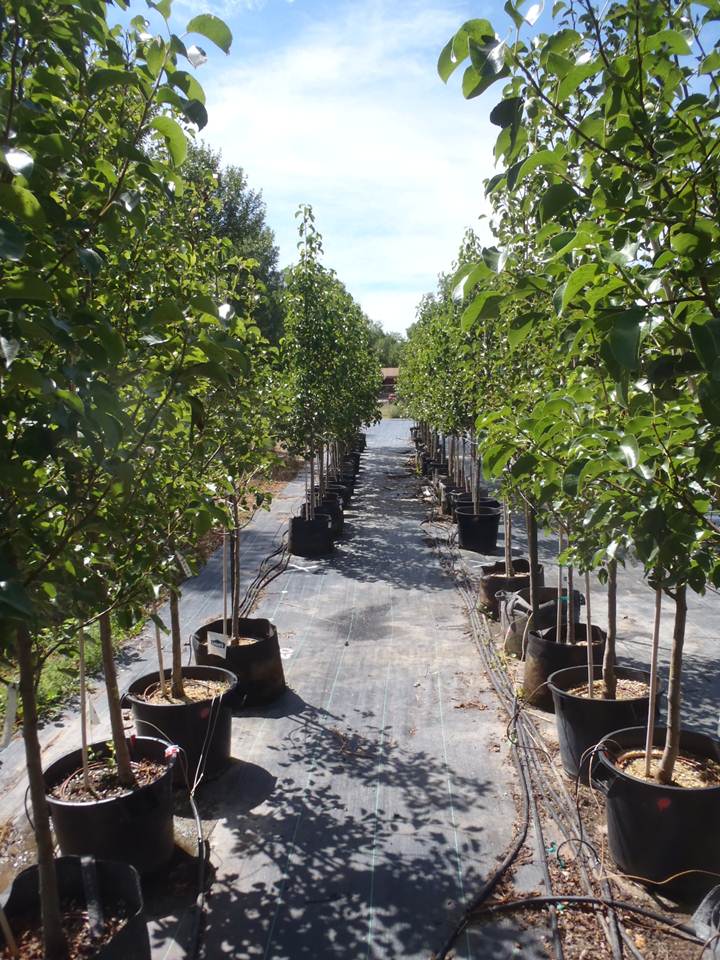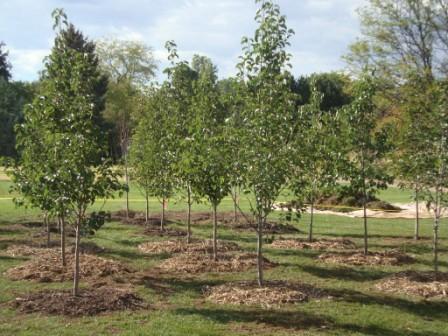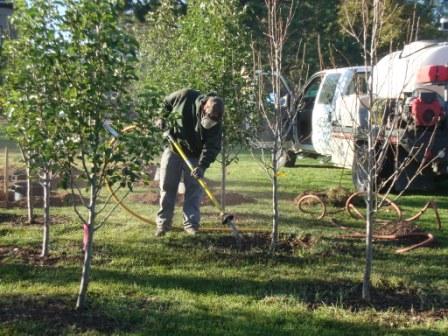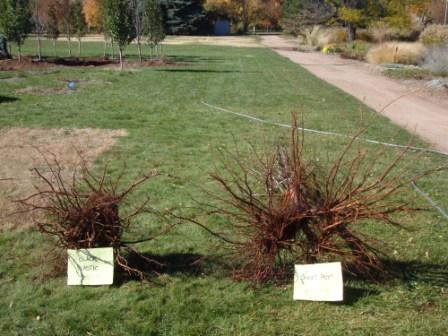One of the best things about my job is I get to work around bright, enthusiastic young people everyday. And not just students here at MSU. Through conferences, meetings and other contacts I get to interact with students at other universities as well. Over the last couple of years I have had a chance to sit in on a couple talks by Alison Stoven O’Connor, who is an Extension Agent and Ph.D. student under the direction of Jim Klett and Tony Koski in Horticulture and Landscape Archetiecture at Colorado State University (and you thought you were busy!). For her Ph.D. research Alison is working on a subject near and dear to the hearts of the Garden Professors; nursery production and tree root development. After I saw her talk at the ASHS meeting this summer I invited Alison to take slot as a guest blogger but she declined, citing her time constraints – we’ll call it an excused absence. She did, however, graciously share some photos from her trial which, as you’ll see, pretty much speak for themselves.
A brief run-down on Alison’s study. She grew Chanticleer pear trees in #15 containers, including both standard black plastic containers and Smart Pot fabric containers in summer 2010. After growing the trees in the nursery for the summer, she transplanted the trees into a landscape-type planting in the fall of 2010. Last week (remember you come to the Garden Professors to get the latest!) she began sampling the roots of a subset of her trees with the aid of a local landscape company with an air spade. The depth of rooting appears to be consistent regardless of the type of container the tree was grown in. Width of the root system; that’s another story… While Alison has a ways to go in gathering and analyzing data, the photographic evidence looks pretty good for the Smart pots over the status quo.

Trees in nursery production.

Trees in the ‘Landscape’ after transplanting,

Air spading to harvest roots

Root systems two years after planting in the landscape. Left – tree grown in conventional black plastic pot. Right – tree grown in Smart Pot. 630 miles between East Lansing and Minneapolis and I can already hear Jeff gloating, “Neener, neener, neener…”
Dramatic demonstration! The problem I see is the extra cost for the Smart Pots. I’m not in commercial production but a very brief search seems to indicate the Smart Pots are about twice the price of a standard plastic pot. Will the nursery industry consider the potential long term benefits versus the immediate profit for one pot over the other?
Hi Bert,
Neener, neener, neener.
Hi Sandy,
Yes, they are likely a little higher in price than black plastic. They also are not re-usable, like black plastic containers–you have to cut the fabric bag off to plant the trees in the ground. There are pros and cons to using any container, but with a more “natural” root system developing with Smart Pot trees, the pros may out
weigh the cons. (As an aside, we are also studying another fabric container called the Root Pouch.) Our research will continue for at least one additional season, and we’ll continue to collect data. I don’t know if fabric containers will ever replace black plastic, but the results are very interesting in our clay soils!
What, if anything, was done to the root balls of the trees in plastic pots? Would that make a difference?
Hi Deirdre,
We planted all the trees in the same way. Aside from cutting off or removing the fabric or container, the rootballs were scored with a box cutter before planting in a hole to BMP standards. We did not shave or “tease apart” the root systems. There have been a few studies that have manipulated the root systems of containerized trees, and Dr. Cregg is currently researching a component of that in his SoMeDed study.
Alison, was there any noticeable difference in the root systems when they were removed from the pots?
Before planting in the landscape, we observationally noted more circling roots on the outer periphery of the rootballs from trees in black plastic (and also more root matting on the bottom). In the other part of the study, where we destructively harvested nursery trees after one and two growing seasons, we saw differences among the container types with black plastic trees having smaller leaf area, root:shoot ratios, height and caliper. We measured fresh and dry root weight and did not have stastical differences for the container types. We are still dissecting the roots to see if there are differences between fine (October 24, 2012
by
GaryWhat’s the cost difference?
Will the advantages of fabric persist? I wonder what the difference in health / yield will be over the life of the tree.October 24, 2012
by
MichaelI wish nurseries would sell more younger trees that aren’t planted in ridiculous soil depths and then left to grow for years in pots to girdle themselves to near death. Then the type of pot wouldn’t be an issue.November 01, 2012
by
Jim AvernaAs more and more creditable horticultureist and Universities test fabric pots against plastic pots to determine any advantages over the other in the performance of the plants.
Many such test are now being conducted across the U.S. and Canada.
The results are now being evaluated and every one without exception is reporting many benefits of using fabric over plastic.
One misconception is fabric can only be used once, fabric can be washed and reused for many seasons. Another misconception is fabric is much more expensive than plastic. Not true some fabric companies have improved production and are now priced competivly if not less than plastic.
Another consideration is not only is fabric a better growing environment for plants but the impact on our environment and landfills, fabric containers leave a carbon footprint that is minisqule in comparison to its plastics counter part.November 07, 2012
by
Alison O’ConnorHi Jim,
While I don’t dispute what you say, in our studies in Colorado, we have not found re-using fabric containers to be a possibility. Even with one-year old trees, we had to physically cut the containers off. You propose another great research topic!December 05, 2012
by
Jim AvernaAlison Thank you for mentioning Root Pouch was also in the test. The guest blogger mentioned that the test was conducted With Smart Pot and Plastic. Root Pouch fabric pots played an equal roll in the test with great results.July 14, 2013
by
darisHi, I was wondering if there was a publication of the results of the research available anywhere, esp the root pouches?
Thanks!
What’s the cost difference?
Will the advantages of fabric persist? I wonder what the difference in health / yield will be over the life of the tree.
I wish nurseries would sell more younger trees that aren’t planted in ridiculous soil depths and then left to grow for years in pots to girdle themselves to near death. Then the type of pot wouldn’t be an issue.
As more and more creditable horticultureist and Universities test fabric pots against plastic pots to determine any advantages over the other in the performance of the plants.
Many such test are now being conducted across the U.S. and Canada.
The results are now being evaluated and every one without exception is reporting many benefits of using fabric over plastic.
One misconception is fabric can only be used once, fabric can be washed and reused for many seasons. Another misconception is fabric is much more expensive than plastic. Not true some fabric companies have improved production and are now priced competivly if not less than plastic.
Another consideration is not only is fabric a better growing environment for plants but the impact on our environment and landfills, fabric containers leave a carbon footprint that is minisqule in comparison to its plastics counter part.
Hi Jim,
While I don’t dispute what you say, in our studies in Colorado, we have not found re-using fabric containers to be a possibility. Even with one-year old trees, we had to physically cut the containers off. You propose another great research topic!
Alison Thank you for mentioning Root Pouch was also in the test. The guest blogger mentioned that the test was conducted With Smart Pot and Plastic. Root Pouch fabric pots played an equal roll in the test with great results.
Hi, I was wondering if there was a publication of the results of the research available anywhere, esp the root pouches?
Thanks!